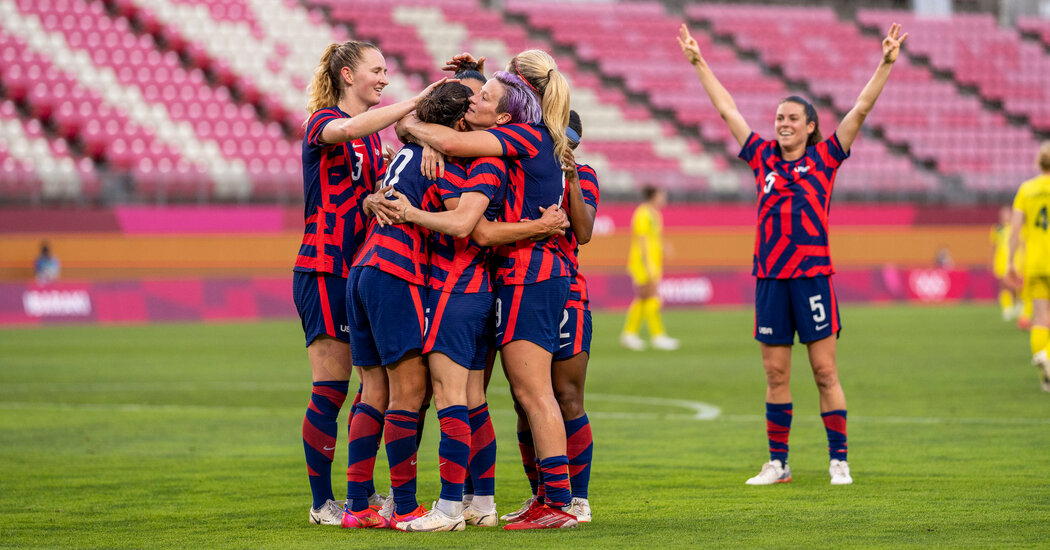
As the women’s soccer stars stared at their laptop screens Monday night and the new labor deal was explained to them, the numbers just kept climbing. A few thousand dollars here. Tens of thousands of dollars there. Pretty soon, the figures had crossed into the millions.
What they added up to, the players all knew, was something many of them had chased for most of their careers: equal pay.
That reality arrived Wednesday in landmark contracts with the U.S. Soccer Federation that will guarantee, for the first time, that soccer players representing the United States men’s and women’s national teams will receive the same pay when competing in international matches and competitions.
In addition to equal rates of pay for individual matches, the deals include a provision, believed to be the first of its kind, through which the teams will pool the unequal prize money payments U.S. Soccer receives from FIFA, world soccer’s governing body, for their participation in the quadrennial World Cup. Starting with the 2022 men’s tournament and the 2023 Women’s World Cup, that money will be shared equally among the members of both teams.
“No other country has ever done this,” U.S. Soccer’s president, Cindy Cone, said of the deal to equalize World Cup payments. “I think everyone should be really proud of what we’ve accomplished here. It really, truly, is historic.”
The agreements were reached just over six years after a group of stars from the World Cup-winning U.S. women’s national team began a campaign to overcome what they said was years of wage discrimination by U.S. Soccer against its female players. The players argued that they had been paid less than their male counterparts for decades even as they won world championships and Olympic gold medals.
The fight over per diems and paychecks eventually morphed into a federal lawsuit in which the women accused U.S. Soccer of “institutionalized gender discrimination.” While the women lost in federal court in 2020, when a judge ruled against their core claims, they eventually won their equal pay victory at the negotiating table, with a final assist from the men’s team.
It was the men’s team’s players, in fact, who opened a pathway to a deal late last year when they privately agreed to share some of the millions of dollars in World Cup bonus money that they have traditionally received by pooling it with the smaller payments the women receive from their own championship.
That split could see the two teams pool, and share, $20 million or more as soon as next year. That will be in addition to match payments that are expected to average $450,000 a year — and double that, or more, in years when World Cup bonus money is added.
For the women’s team’s players, Wednesday’s agreements were as much a relief as a triumph. Becky Sauerbrunn, one of the five players who signed the original complaint in 2016, admitted, “It’s hard to get so, so excited about something we should have had all along.”
Through the years, as the sides battled in courtrooms and negotiating sessions, the dispute produced sometimes caustic — and personal — disagreements about personal privacy, workplace equality and basic fairness, and drew support (and second-guessing) from a disparate chorus of presidential candidates, star athletes and Hollywood celebrities — not all of them supportive of the women’s campaign for pay equity.
The difference in compensation for men and women has been one of the most contentious issues in soccer in recent years, particularly after the American women won consecutive World Cup championships, in 2015 and 2019, and the men failed to qualify for the 2018 tournament. Over the years, the women’s team, which includes some of the world’s most recognizable athletes, had escalated and amplified its fight in court filings, news media interviews and on the sport’s grandest stages.
The dispute had always been a complex issue, with differing contracts, unequal prize money and other financial quirks muddying the distinctions in pay between the men’s and women’s teams and complicating the ability of national governing bodies like U.S. Soccer to resolve the differences.
Yet the federation ultimately committed to a fairer system. To achieve it, U.S. Soccer will distribute millions of extra dollars to its best players through a complicated calculus of increased match bonuses, pooled prize money and new revenue-sharing agreements. These agreements will give each team a slice of the tens of millions of dollars in commercial revenues that U.S. Soccer receives each year from sponsors, broadcasters and other partners.
Labor peace will be expensive: U.S. Soccer has committed to single-game payments for most matches of $18,000 per player for games won, and as much as $24,000 per game for wins at certain major tournaments — cementing the status of the U.S. men and women as two of the highest-paid national teams in the world. And the federation will surrender to the men and women on those teams 90 percent of the money it receives from FIFA for sending teams to the next two World Cups.
The split of prize money, then, is a notable concession by the American men, who have previously been awarded the bulk of those multimillion-dollar payments by U.S. Soccer, and a potential seven-figure windfall for the women. The 24 teams at the 2019 Women’s World Cup in France, for example, competed for a prize pool of $30 million; the 32 men’s teams that will compete in Qatar in November will split $450 million.
Timeline: U.S. Women’s National Soccer Team’s Fight for Equal Pay
“When we got together as a group, certainly we saw that there was not going to be a way forward without the equalization of prize money,” said Walker Zimmerman, a defender on the men’s team and a member of his union’s leadership group. He said the process of persuading the rest of his teammates to share the money involved “difficult conversations, a lot of listening, a lot of learning.”
The team’s willingness to part with some of the money, though, removed what the federation and the players alike had long agreed was the one seemingly insurmountable obstacle to a deal.
“They were true champions of this,” Cone said of the men’s team’s embrace of equalizing pay more broadly and prize money specifically. “It’s not easy to give up the money they’re giving up. To know it’s the right thing to do, and then to step up and do it, I think they should be applauded.”
While several of the women praised the men’s willingness to narrow the biggest pay discrepancies, and cited that as a big reason for the new contracts, veterans of the equal pay fight — and the C.B.A. talks — were more measured in their reactions.
“I feel a lot of pride that there are going to be girls who are going to grow up and see what we’ve accomplished and recognize their value instead of having to fight to see it themselves,” said Midge Purce, a member of the collective bargaining committee for the women’s players’ association.
“But my dad always told me, ‘You don’t get a reward for doing what you’re supposed to do,’” she added. “And paying men and women equally is what you’re supposed to do.”
Despite its cost, the new equal pay policy has incalculable value for all involved, as it will end a six-year battle that battered the federation’s reputation, threatened U.S. Soccer’s relationships with important sponsors and ran up millions of dollars in legal fees on every side of the fight.
Resolving the fight amicably, rather than in court, could make it easier for the federation to attract new sponsors and rebuild bonds with its most prominent players. And by offering the teams a share of its commercial revenues, U.S. Soccer has essentially incentivized its biggest stars to act as partners in finding new ways to increase those revenue streams.
And the men’s and women’s pay will still not be entirely equal: Injuries, coaching decisions and even the number of games played by each team will continue to affect what individual players can earn. But for the most prominent American female players, the deals could soon deliver an immediate payday by unlocking a $24 million settlement, largely for back pay, that they reached with U.S. Soccer in February to settle the gender discrimination lawsuit. U.S. Soccer had made that one-time payment contingent on reaching new collective bargaining agreements that formalized equal pay between the teams.
With the new deals approved, U.S. Soccer can now seek the judge’s approval to start cutting checks.




